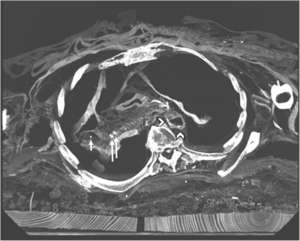Infectious Disease in the Neolithic: Difference between revisions
| Line 25: | Line 25: | ||
== | ==Major Pathogens== | ||
<b><i>Mycobacterium tuberculosis</i></b><br> | |||
< | |||
Genetic evidence of <i>Mycobacterium tuberculosis</i>, the causative agent of tuberculosis, has been found as early as 5000 years ago. It is most often identified as a Mycobacterium tuberculosis complex, a larger group that is recognized by standard DNA probes (CITE). The complex includes M. tuberculosis, M. bovis, M. africanum, and M. microti. M. tuberculosis is one of the most common causes of tuberculosis, but M. bovis and M. africanum can result in similar symptoms in humans (CITE). Of these, M. bovis mostly affects cattle but can infect humans if infected meat and dairy products are ingested, while M. africanum is responsible for the majority of tuberculosis cases in Africa (CITE). M. microti specifically affects mice and voles (CITE). | |||
==Section 2== | ==Section 2== | ||
Revision as of 05:19, 14 April 2024
Section

By [Author Name]
At right is a sample image insertion. It works for any image uploaded anywhere to MicrobeWiki.
The insertion code consists of:
Double brackets: [[
Filename: PHIL_1181_lores.jpg
Thumbnail status: |thumb|
Pixel size: |300px|
Placement on page: |right|
Legend/credit: Magnified 20,000X, this colorized scanning electron micrograph (SEM) depicts a grouping of methicillin resistant Staphylococcus aureus (MRSA) bacteria. Photo credit: CDC. Every image requires a link to the source.
Closed double brackets: ]]
Other examples:
Bold
Italic
Subscript: H2O
Superscript: Fe3+
Sample citations: [1]
[2]
A citation code consists of a hyperlinked reference within "ref" begin and end codes.
Major Pathogens
Mycobacterium tuberculosis
Genetic evidence of Mycobacterium tuberculosis, the causative agent of tuberculosis, has been found as early as 5000 years ago. It is most often identified as a Mycobacterium tuberculosis complex, a larger group that is recognized by standard DNA probes (CITE). The complex includes M. tuberculosis, M. bovis, M. africanum, and M. microti. M. tuberculosis is one of the most common causes of tuberculosis, but M. bovis and M. africanum can result in similar symptoms in humans (CITE). Of these, M. bovis mostly affects cattle but can infect humans if infected meat and dairy products are ingested, while M. africanum is responsible for the majority of tuberculosis cases in Africa (CITE). M. microti specifically affects mice and voles (CITE).
Section 2
Include some current research, with at least one figure showing data.
The Neolithic, a period between 10000 BCE and 2200 BCE in Europe, Asia, and Africa, is characterized by a shift from the general hunter-gatherer lifestyle to one revolving around permanent settlements and a newfound reliance on agriculture. The origins of infectious diseases like tuberculosis (caused by bacteria of the Mycobacterium tuberculosis complex) has often been attributed to the Neolithic, with increasing population densities, permanent settlements, and more frequent interactions with domesticated animals. Some recent genomic research suggests that the conditions of the Neolithic were merely catalysts for the spread of tuberculosis, while others argue that the common ancestor of modern tuberculosis-causing Mycobacterium was much younger. These data follow a similar trend as research on ancient Salmonella genomes, which point to the Neolithic Revolution as a major event in the emergence of human-adapted pathogens.
Reference [3]
Ref 2 [4]
Section 3
Include some current research, with at least one figure showing data.
Section 4
Conclusion
References
- ↑ Hodgkin, J. and Partridge, F.A. "Caenorhabditis elegans meets microsporidia: the nematode killers from Paris." 2008. PLoS Biology 6:2634-2637.
- ↑ Bartlett et al.: Oncolytic viruses as therapeutic cancer vaccines. Molecular Cancer 2013 12:103.
- ↑ Hodgkin, J. and Partridge, F.A. "Caenorhabditis elegans meets microsporidia: the nematode killers from Paris." 2008. PLoS Biology 6:2634-2637.
- ↑ Fuchs, Katharina, Christoph Rinne, Clara Drummer, Alexander Immel, Ben Krause-Kyora, and Almut Nebel. “Infectious Diseases and Neolithic Transformations: Evaluating Biological and Archaeological Proxies in the German Loess Zone between 5500 and 2500 BCE.” 2019. The Holocene 29 (10): 1545–57.
Authored for BIOL 238 Microbiology, taught by Joan Slonczewski,at Kenyon College,2024
